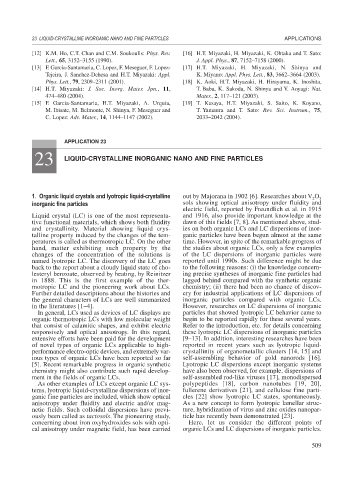Page 537 - Book Hosokawa Nanoparticle Technology Handbook
P. 537
23 LIQUID-CRYSTALLINE INORGANIC NANO AND FINE PARTICLES APPLICATIONS
[12] K.M. Ho, C.T. Chan and C.M. Soukoulis: Phys. Rev. [16] H.T. Miyazaki, H. Miyazaki, K. Ohtaka and T. Sato:
Lett., 65, 3152–3155 (1990). J. Appl. Phys., 87, 7152–7158 (2000).
[13] F. Garcia-Santamaria, C. Lopez, F. Meseguer, F. Lopez- [17] H.T. Miyazaki, H. Miyazaki, N. Shinya and
Tejeira, J. Sanchez-Dehesa and H.T. Miyazaki: Appl. K. Miyano: Appl. Phys. Lett., 83, 3662–3664 (2003).
Phys. Lett., 79, 2309–2311 (2001). [18] K. Aoki, H.T. Miyazaki, H. Hirayama, K. Inoshita,
[14] H.T. Miyazaki: J. Soc. Inorg. Mater. Jpn., 11, T. Baba, K. Sakoda, N. Shinya and Y. Aoyagi: Nat.
474–480 (2004). Mater., 2, 117–121 (2003).
[15] F. Garcia-Santamaria, H.T. Miyazaki, A. Urquia, [19] T. Kasaya, H.T. Miyazaki, S. Saito, K. Koyano,
M. Ibisate, M. Belmonte, N. Shinya, F. Meseguer and T. Yamaura and T. Sato: Rev. Sci. Instrum., 75,
C. Lopez: Adv. Mater., 14, 1144–1147 (2002). 2033–2042 (2004).
APPLICATION 23
23 LIQUID-CRYSTALLINE INORGANIC NANO AND FINE PARTICLES
1. Organic liquid crystals and lyotropic liquid-crystalline out by Majorana in 1902 [6]. Researches about V O 5
2
inorganic fine particles sols showing optical anisotropy under fluidity and
electric field, reported by Freundlich et al. in 1915
Liquid crystal (LC) is one of the most representa- and 1916, also provide important knowledge at the
tive functional materials, which shows both fluidity dawn of this fields [7, 8]. As mentioned above, stud-
and crystallinity. Material showing liquid crys- ies on both organic LCs and LC dispersions of inor-
talline property induced by the changes of the tem- ganic particles have been begun almost at the same
peratures is called as thermotropic LC. On the other time. However, in spite of the remarkable progress of
hand, matter exhibiting such property by the the studies about organic LCs, only a few examples
changes of the concentration of the solutions is of the LC dispersions of inorganic particles were
named lyotropic LC. The discovery of the LC goes reported until 1990s. Such difference might be due
back to the report about a cloudy liquid state of cho- to the following reasons: (i) the knowledge concern-
lesteryl benzoate, observed by heating, by Reinitzer ing precise syntheses of inorganic fine particles had
in 1888. This is the first example of the ther- lagged behind compared with the synthetic organic
motropic LC and the pioneering work about LCs. chemistry; (ii) there had been no chance of discov-
Further detailed descriptions about the histories and ery for industrial applications of LC dispersions of
the general characters of LCs are well summarized inorganic particles compared with organic LCs.
in the literatures [1–4]. However, researches on LC dispersions of inorganic
In general, LCs used as devices of LC displays are particles that showed lyotropic LC behavior came to
organic thermotropic LCs with low molecular weight begin to be reported rapidly for these several years.
that consist of calamitic shapes, and exhibit electric Refer to the introduction, etc. for details concerning
responsively and optical anisotropy. In this regard, these lyotropic LC dispersions of inorganic particles
extensive efforts have been paid for the development [9–13]. In addition, interesting researches have been
of novel types of organic LCs applicable to high- reported in recent years such as lyotropic liquid-
performance electro-optic devices, and extremely var- crystallinity of organometallic clusters [14, 15] and
ious types of organic LCs have been reported so far self-assembling behavior of gold nanorods [16].
[5]. Recent remarkable progress in organic synthetic Lyotropic LC dispersions except inorganic systems
chemistry might also contribute such rapid develop- have also been observed, for example, dispersions of
ment in the fields of organic LCs. self-assembled rod-like viruses [17], monodispersed
As other examples of LCs except organic LC sys- polypeptides [18], carbon nanotubes [19, 20],
tems, lyotropic liquid-crystalline dispersions of inor- fullerene derivatives [21], and cellulose fine parti-
ganic fine particles are included, which show optical cles [22] show lyotropic LC states, spontaneously.
anisotropy under fluidity and electric and/or mag- As a new concept to form lyotropic lamellar struc-
netic fields. Such colloidal dispersions have previ- ture, hybridization of virus and zinc oxides nanopar-
ously been called as tactosols. The pioneering study, ticle has recently been demonstrated [23].
concerning about iron oxyhydroxides sols with opti- Here, let us consider the different points of
cal anisotropy under magnetic field, has been carried organic LCs and LC dispersions of inorganic particles.
509

